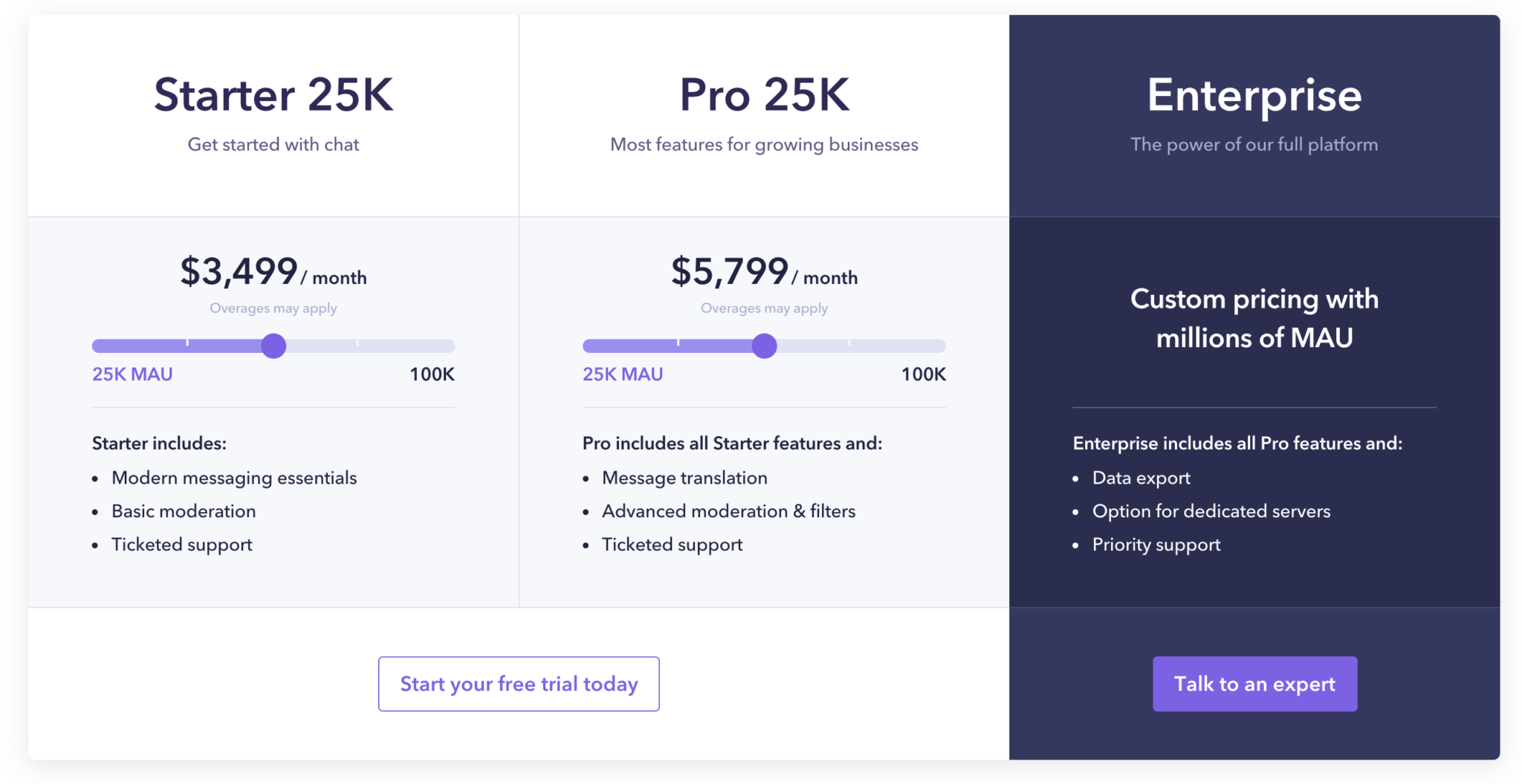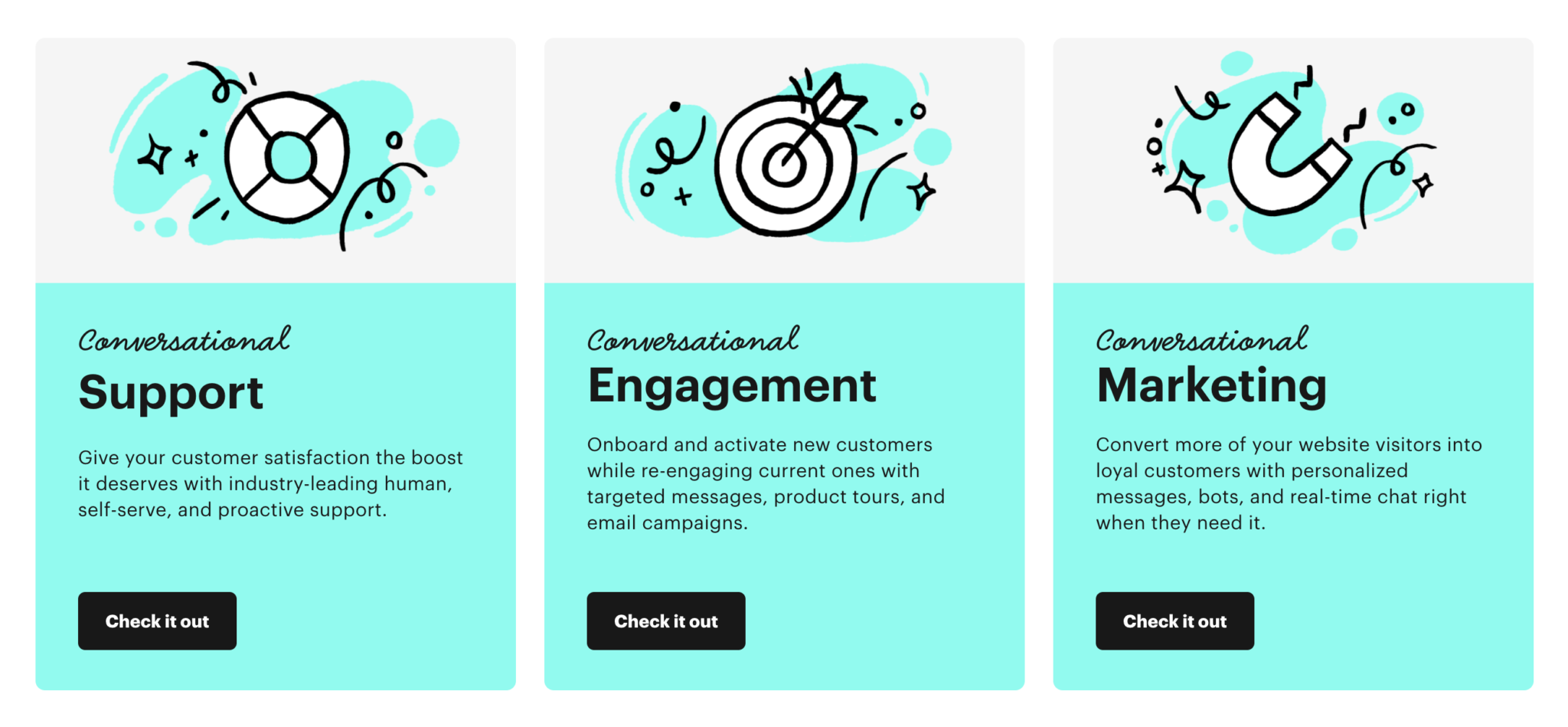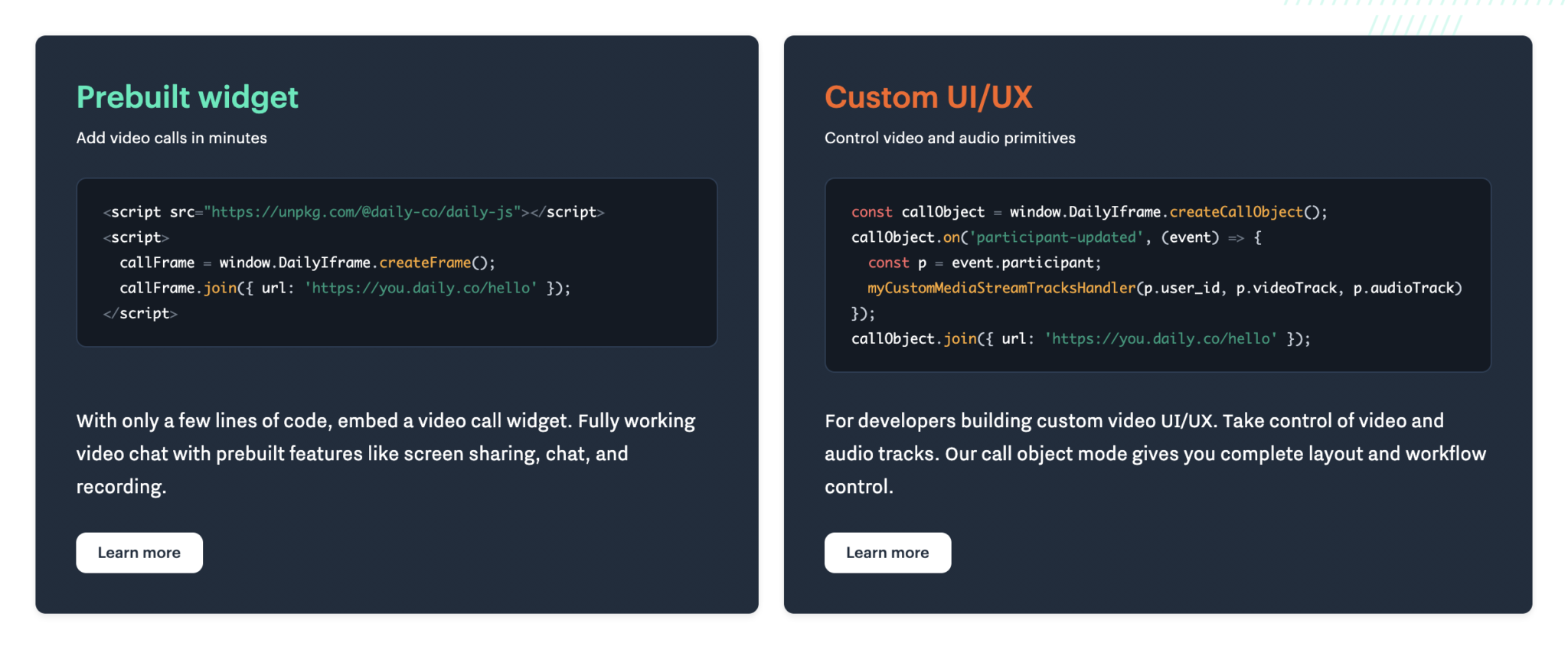The guide to white-label chat
If you’re looking for a white-label chat solution, you’re probably having a hard time deciding what solution to pick. As it can be overwhelming navigating through the current chat market because of the sheer number of products out there. From customer support chat widgets to open-source APIs and even chatbot builders, it’s no wonder customers find themselves in an analysis-paralysis situation. So, to untangle the mess and help you pick the right tool we wrote this comprehensive overview of white-label chat solutions.
Types of white label chat solutions:
- General-purpose chat APIs
- Customer support widgets (Live chat)
- Open-source chat APIs
- Open-source team collaboration tools
- White-label video chat APIs
- White-label chatbots
Mapping the chat landscape (comparison table)
You can use tonnes of unique solutions to build a chat feature and embed it into your website or app. Here’s a quick overview of what’s on the market to help you sort through all the various products.
General-purpose chat APIs – flexible messaging APIs (Application Program Interface) that allow you to build almost any type of messaging or white-label chat experience.
Customer support widgets – are white-label chat solutions that are easy to integrate into a website but with limited customizability. They are often restricted by their built-in features, often with no way to add custom ones.
Open-source chat APIs – great if you’re building a messaging feature from scratch, as they do not provide the infrastructure and the chat UI. Because of the nature of open-source software, you have to maintain and service the chat solution by yourself.
Open-source team collaboration tools – work best for collaboration and team interaction features. These open-source solutions are highly customizable, but the ready-to-use features will often be restricted to use cases designed for team collaboration.
White-label video chat APIs – help you build any solution for real-time video conversations in a similar manner as general-purpose APIs.
White-label chatbots – can help you automate sales and support tasks by creating a personalized customer experience on a large scale. Note that developers can also integrate chatbot AI technology into any of the above-mentioned messaging APIs.
| Type | Pros | Cons | Best fit for | Pricing |
|---|---|---|---|---|
| General-purpose chat APIs | • ship robust messaging apps fast with ready-to-use features and UI components • you don’t have to manage the infrastructure • highly customizable | • few providers offer on-premise installation some solutions • can get very expensive for large user bases | Companies that have at least a small dev team and have custom requirements. | Usually based on monthly-active-users. Pay as you grow. |
| Customer support widgets | • tailored for the customer support and sales use case • easy to integrate (copy paste a code snippet) | • you can use only the default chat features • no support for other use cases | Companies with limited dev resources that are comfortable with using just the default features. | Priced by user seats. Can get very expensive for large sales and support teams. |
| Open-source chat APIs | • highly customizable • great for custom use cases and specific requirements | • time to market • create the frontend basically from scratch • manage the infrastructure by yourself | Larger dev team needed to build a good part of the chat from scratch. | The code libraries are free to use, but you have to pay for the servers and account for the additional dev hours. |
| Open-source team collaboration tool | • highly customizable • build a custom team collaboration tool | • time to market • don’t support other use cases • manage the infrastructure by yourself | Larger dev team is needed to build a good part of the solution from scratch. Great if proprietary solutions like Slack are not an option. | The codebase is free to use but you have to manage the infrastructure. |
| White-label video chat APIs | • create robust video chat features fast with out-of-the-box features • you don’t have to manage the infrastructure • highly customizable | • few providers offer on-premise installation • some providers don’t support standard messaging features only video | Companies with a small dev team and custom requirements. | Based on the duration of video calls. |
| White-label chatbots | • build custom chatbots | • time to market | Companies with a small dev team that need custom chatbots, and if solutions like Intercom and Drift are not an option. | Priced on the number of speech and text requests. |
General-Purpose Chat APIs
If you’re looking for a fast way to build a white label chat, general-purpose APIs are a great choice. They offer all the flexibility for building almost any kind of messaging experience and a chat UI that will fit your design.
They range from nuts and bolts solutions like Twilio and Pubnub that provide the infrastructure and the backend, but no UI components or out-of-the-box features, and take longer to deploy. Next, we have Stream and Sendbird that have building blocks (UI components and ready-to-use features) you can use to assemble a chat feature. Also, there are Chat APIs like TalkJS that come with an entirely pre-built and customizable UI.
This type of APIs works best for companies that don’t want to build everything from scratch but need a lot of flexibility when creating messaging features. The cost of general-purpose chat APIs is usually based on monthly active users, so you will pay a relatively small monthly fee in the beginning but more as your user base grows. Now let’s take a look at a couple of well-known chat APIs.
SendBird is the current market leader in the chat API space and is priced accordingly, making it 3-5 times more expensive than the other solutions out there. It’s a “building blocks” type of chat API you can use to assemble a messaging solution faster than with open source but at a hefty price. They provide the infrastructure and UI components, and their chat API has video and voice capabilities.

TalkJS is focused on providing out-of-the-box and pre-built features so that developers can ship messaging apps faster than with other APIs. You get the backend and the frontend with a drop-in chat UI that’s highly customizable. There’s no need to assemble building blocks to create messaging features and the UI. Everything works plug and play.
Stream is an API similar to Sendbird that comes at a more acceptable price. It’s still a building blocks type of solution with a UI kit (components and design files for Sketch).
Customer Support Widgets
If what you need us a live chat for your support and sales teams, customer support widgets could be a great pick. Solutions like Intercom fall into this category and work well if the default features are precisely what you need. Pricing will depend on the number of sales/support agents, and it can become costly for larger teams. In that case, it could be much cheaper to build your own chat solution with a general-purpose API that is priced per MAU. It will take some dev work but could be more affordable in the long run.
Intercom is a well-balanced, all-in-one tool covering support, marketing, and sales tasks through live chat, knowledge base, and email automation. One of its unique features allows you to integrate contextual tips into your product without the help of third-party solutions.

Drift offers the same highly developed bots built for live chats, knowledge base, and email automation, but it works through a more sales-oriented or enterprise-oriented perspective. It also has a unique account-based marketing feature, along with its sophisticated chat support features.
Open-Source Chat APIs
Open-source chat APIs work best for companies with specific feature requirements that don’t mind building many messaging features from scratch. They provide the complete source code, which allows your team of developers to document and change the existing code and tailor it to what your company needs. Open-source chat APIs, just like with all open-source tools, have their own upsides and downsides.
For example, user experience sometimes gets compromised because the dev support isn’t always reliable every time there is an API issue. However, many developers consider these solutions to be the most cost-effective as the code base is free to use.
Chat SDK gives you the option to build an entirely custom messaging application from scratch. Its rich feature list (e.g., private and public groups, user profiles, basic login, social login, etc.) expands with its scalability, dual-license, and support for iOS and Android.
Mesibo reinforces the complexities of chat and messaging solutions by providing a cross-platform API with a scalable carrier-grade platform. It can also support millions of concurrent calls and messaging because of its low latency and high-reliability features.
White-Label Video Chat APIs
This API type makes it easy to build a cross-platform video-conferencing application in a similar way you would use a general-purpose chat API. Although it doesn’t seem as affordable as open-source APIs, it allows your team to ship chat features much faster.
Daily is a cloud-based video calling platform that can help your company manage video calls, conference rooms, recording, and more. It offers the fastest time-to-value video API platform to save time and money by using dev resources more efficiently.

Agora is another video calling solution that can deliver individual and multi-party video call and conferencing features. It can offer low-latency results while providing high-quality video calls across platforms such as iOS, Android, and the web.
Sinch provides seamless integration of its video calling features with a quick import of lightweight SDK to enhance users’ collaboration. With this video chat solution, your team can integrate existing or new applications while offering high-quality video calls on any of the three major platforms.
Open-Source Team Communication Tools
They work just like any other open-source code base, but they’re tailored for the team collaboration use case. Companies use them when products like Slack become so expensive or lacking in features that it’s more cost-effective to build your own team communication software.
Rocket chat is a complete open-source communication tool built on Meteor, JavaScript and MongoDB, and a NoSQL Document Database. It can be installed anywhere, as it is self-hosted, and it provides a rich API set that lets your team build applications on top.
Zulip is a complete messaging platform with a full open-source communication solution, and it has features that are customizable for Android and iOS clients. It also offers integration with dozens of enterprise tools and solutions like GitHub, JIRA, Zendesk, Sentry, and Travis CI.
White-Label Chatbots
In the last couple of years, we’ve seen chatbots popping up all over the web, mostly as part of the ‘conversational marketing’ hype providers like Intercom and drift were promoting. Although both providers offer chatbots, there’s no way to white label the UI or integrate custom chatbot features. That’s where chatbot APIs come into play; they work similar to general-purpose APIs and make it easy to create a chatbot that fits into your app brand and design.
Dialogflow relies on human-computer interaction technologies that are often based on natural language conversations. It provides a web interface for creating bots, allowing easy integration with any other messaging chat solutions.
LUIS offers features and functionality similar to that of Dialogflow. It also provides a programming framework that can develop dialogue logic for complex dialogues while providing integrations to the Azure active directory, Skype, and Facebook.
Lex has similar functionality to Dialogflow, where it is built using conversational interfaces through voice and/or text. Although it works similarly, it limits its integration to Facebook, Kik, Slack, and Twilio SMS.
The Bottom Line
When choosing a white label chat solution, the main thing you should consider is the time it’ll take to ship the feature, and of course, check if the API is even possible of supporting what you intend to do. With open-source APIs, you can build a simple chat for almost no cost, but creating a feature-packed and scalable solution will require serious development resources. On the other hand, you have general-purpose proprietary APIs that can help you ship fast, not worry about the infrastructure, and even provide the entire chat UI out-of-the-box, but at some providers for a hefty price. The third option is customer support widgets that you can implement fast by pasting the code snippet into your website, but bear in mind that their default features can be very limiting.
